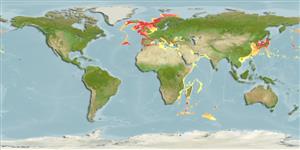Common names from other countries
Classification / Names / Names
Common names | Synonyms | Catalog of Fishes (gen., sp.) | ITIS | CoL | WoRMS
Environment: milieu / climate zone / depth range / distribution range
Ecology
Sessile; depth range 0 - 1600 m (Ref. 108103). Subtropical; 73°N - 36°S, 26°W - 143°E
North and South Atlantic, Mediterranean and Pacific: From Atlantic Europe to northern Russia, the Mediterranan, South Africa and Japan.
Length at first maturity / Size / Weight / Age
Maturity: Lm ? range ? - ? cm Max length : 8.0 cm H male/unsexed; (Ref. 363)
Approximately 6 to 8 cm in height and less than 10 cm in diameter in extension (Ref. 363). Occurs at the water line, especially in sheltered places such as the inside of harbor walls (green Actinia), red Actinia can occasionally be encountered in the intertidal zone of Azores (Ref. 201)); Common run on the rocks, the surface to a few meters of depth (Ref. 363). Also found in infralittoral zones (Ref. 85338). Solitary (Ref. 2377).
Life cycle and mating behavior
Maturity | Reproduction | Spawning | Eggs | Fecundity | Larvae
Members of the class Anthozoa are either gonochoric or hermaphroditic. Mature gametes are shed into the coelenteron and spawned through the mouth. Life cycle: The zygote develops into a planktonic planula larva. Metamorphosis begins with early morphogenesis of tentacles, septa and pharynx before larval settlement on the aboral end.
Wirtz, P., O. Ocaña and T. Molodtsova. 2003. (Ref. 201)
IUCN Red List Status (Ref. 130435)
CITES status (Ref. 108899)
Not Evaluated
Not Evaluated
Human uses
| FishSource |
Tools
More information
Age/SizeGrowthLength-weightLength-lengthMorphologyLarvaeAbundance
Internet sources
Estimates based on models
Preferred temperature
(Ref.
115969): 0.6 - 14.2, mean 7.8 (based on 456 cells).
Vulnerability
Low vulnerability (10 of 100).
Price category
Unknown.
